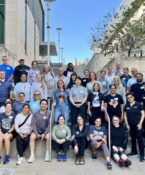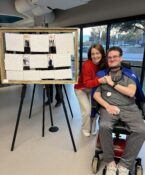HSC researcher eyes NBA finals
 Dr. Dimitrios Karamichos was paying particularly close attention to the NBA finals this year. The executive director and endowed chair of The University of North Texas Health Science Center at Fort Worth’s North Texas Eye Research Institute is a huge basketball fan, but the reason he was watching closer than usual was related to his research.
Dr. Dimitrios Karamichos was paying particularly close attention to the NBA finals this year. The executive director and endowed chair of The University of North Texas Health Science Center at Fort Worth’s North Texas Eye Research Institute is a huge basketball fan, but the reason he was watching closer than usual was related to his research.
After the Golden State Warriors were crowned champions, the team’s highly decorated, future hall-of-fame star, Steph Curry, hoisted the trophy awarded to the finals’ most valuable player.
Just a few years ago, a rare eye disorder threatened the basketball star’s career. When his shooting began to decline, he noticed his vision was worsening, and the eight-time all-star was regularly squinting to see. It wasn’t until Curry made an appointment to be fitted for glasses that he learned he was living with a disease known as keratoconus.
Keratoconus occurs when someone’s cornea — the clear, dome-shaped front surface of the eye — thins and gradually bulges outward into a cone shape. This can cause blurry, distorted vision. In some cases, keratoconus can lead to corneal scarring, thus greatly diminishing vision and even causing blindness.
The cause of keratoconus is unknown, but most researchers think it is a combination of genetics, hormonal imbalances and environmental factors, such as allergies and eye rubbing. It occurs most commonly in late childhood or early adulthood and then mysteriously vanishes at age 40 to 45. Some patients who experience scarring at severe disease stages may require a corneal transplant.
Karamichos and his team at the institute study the disease. One of the many tendrils of the Greek-born researcher’s work is focused on a particular biomarker he thinks can accurately be an indication of keratoconus.
Karamichos, who is the principal investigator on the National Eye Institute-funded project[1], has sent his work on the predictive biomarker — Prolactin Induced Protein, known as PIP — to clinical studies. If the studies prove to be effective, they could have far-reaching significance for people suffering from the disease.
 “The impact could be huge because in terms of treatment, this disease has only corneal transplantation, which comes with numerous drawbacks: You have to be on steroids for the rest of your life, and corneal transplants are known to fail over time,” he said. “If we are correct about this biomarker, I think it will have a huge impact in predicting and possibly managing the disease.”
“The impact could be huge because in terms of treatment, this disease has only corneal transplantation, which comes with numerous drawbacks: You have to be on steroids for the rest of your life, and corneal transplants are known to fail over time,” he said. “If we are correct about this biomarker, I think it will have a huge impact in predicting and possibly managing the disease.”
Karamichos and his team also are developing an eye drop that would treat the disease, so those stricken with it might be able to avoid surgery.
“It’s promising, but it’s not there yet,” he said.
Some of his other work related to keratoconus is also funded by two separate grants from the National Eye Institute: one that looks at the effects of certain hormones[2] that cause keratoconus and another that examines why people with Down syndrome [3] are far more likely to develop keratoconus. More than 50% of people living with Down syndrome contract the disease. This facet of Karamichos’ research is being conducted in conjunction with HSC’s Dr. Melissa Peterson, who is the co-primary investigator.
Karamichos’ long path to HSC started in Manchester, England, with stops in London, Dallas, Boston and Oklahoma City, among others. An electronic engineer by training, he first became interested in studying the cornea during his postdoctoral work at UT Southwestern.
Soon after, he earned a second postdoctoral fellowship at the Schepens Eye Research Institute, Harvard Medical School, where he studied wound healing in the cornea. There, he eventually was introduced to keratoconus. After researching the disease, Karamichos received a grant to study it further.
He has since dedicated much of his professional life to understanding and treating the disease that has robbed countless people of their vision.
Karamichos, who is a fan of the NBA’s San Antonio Spurs, said that during Curry’s remarkable run as a player, he likely has suffered from keratoconus for years and just not known it.
“Chances are he won’t progress to severe stages, but he could progress to a stage where the contacts are too uncomfortable for him to play at the level that he’s playing,” he said. “It could be significant to the point that he will have to undergo surgery. It won’t knock him out. It’s not career ending as long as you get it treated, but if you don’t get treated, you could have severe vision impairment all the way to blindness.”
Despite his loyalty to the Spurs, Karamichos said he feels for Curry and what he’s endured on his journey to greatness.
“This kind of puts things into perspective,” he said. “You realize they’re humans and not untouchable despite their ability to perform at the highest level.”
[1] NIH #5R01EY030028-03 in the amount of $896,556.00
[2] NIH# 7R01EY028888-03 in the amount of $1,090,000; Sex hormones and keratoconus
[3] NIH# 1R21EY032320-01in the amount of $403,584.00; Exploring the role of gonadotropins in Down syndrome





Social media